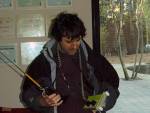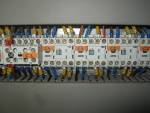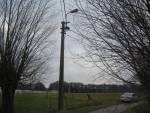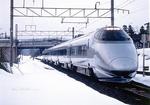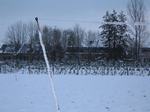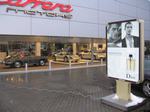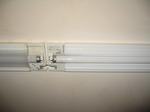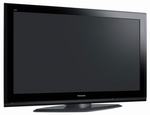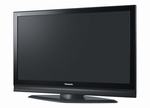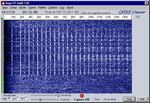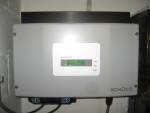The OVERVIEW picture
Click on the picture to get a geopgraphical overview of most of the following
cases.
It is striking that 11 cases are effectively related to (dangerous) electrical anomalies. Mostly found in businesses (restaurants, shops,...), not in ordinary household homes.
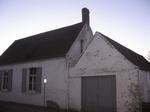
The RAIN GUTTER case
This is one of the first cases I solved. Heavy interference, I couldn't
hear weak signals anymore. I went out for a walk with my first ever RFI-detector,
a simple AM
radio which my grandmother used in her kitchen when I was a kid.
My walk with the radio brought me to a famous restaurant (distance 180
meter), harbored in an old restaurated farm built in 1719. I talked to
the waiter, a young guy. I told him about a radio interference I picked
up, and it seemed to come from the rain gutter of the house. Eh? Well
yes, the rain gutter. He took a ladder and we went for the rain gutter
(click on the picture to the left). I let him listen to the interference.
Okay, he said, let me see. Up he went. In order to get from the ladder
up the tiny platform leading to the external airconditioner and other
equipment, he reached for the rain gutter to use as a support. As soon
as he touched the gutter, he got an electrical shock, shouted in pain,
and instantly the interference on the radio stopped! Back down from the
ladder, still shaking, he asked me if this problem could be connected
to the problem of electrical shocks they got from time to time in the
kitchen, when touching the sink or fridge...
I told him it most probably was related, and probably due to a poor and/or
incorrect grounding. He went to call for the electrician next, after thanking
me for warning them (and for the electrical shock, hi). A pretty dangerous
case closed.
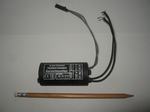
The CE-labeled ELECTRONIC TRANSFORMER
'In Europe the CE marking (also known as CE mark - comes from 'Communauté
Européenne') is a mandatory conformance mark on many products placed
on the single market in the European Economic Area (EEA). The CE marking
certifies that a product has met EU consumer safety, health or environmental
requirements. By affixing the CE marking to a product, the
manufacturer – on his sole responsibility – declares that it
meets EU safety, health and environmental requirements.'
One day I experienced a terrible interference on the 80m band. I went for a walk with my grandmother's AM transistor radio. The RFI seemed to come from the house of the neighbors across the street (distance 65 meter). The neighbor and I used to live and play in the same street when we were kids... it sure is a small world. Upon further investigation in the house, the RFI was pinpointed to a series of halogen lamps on the 1st floor hallway and in two bedrooms, eight (or was it ten?) in total. I took one out of the ceiling, and noticed suspicious 'electronic transformers without brand name' were attached to all of the lamps. I then contacted the company who installed these lightings (10 years prior), and later paid them a visit. I took one of the units along, they didn't recognize it but admitted they must have installed it (10 years is a long time in construction business). They offered me conventional transformers to replace the electronic transformers, at a discount price. After installation, the RFI was gone.
Moral of this one: if the EU lets manufacturers 'affix' CE marking
to their products, without any controlling body monitoring/testing their
products, things like these 'unbranded electronic transformers' come on
the market and can cause havoc. NOT a good idea. In the past 'experiments'
like this had to pass technical scrutiny, nowadays anyone can so to speak
put a CE marking on his product, without it really being compliant.
Addendum January 2021: I learned that the European CE label has
a Chinese counterpart, the China Export label. When you look closer at
the label on the faulty transformer, it is clear this was a China Export
product ! Look
here for the difference between the two CE labels.
I received an interesting e-mail
from Terrence WN4ISX on the subject of halogen lamps and arcing. Learned
something new here, tnx Terrence!
Chuck W1HIS reacted to Terrence's e-mail, and sent me the article 'EMI
Hall of Shame Begins – Halogen Lamp' he wrote for the Technical Correspondence
in QST, May 2005. The ARRL kindly granted permission to post the article
here.
The faulty CEILING LAMP cases
This is another early RFI case I solved. My JA beverage suffered severe
RFI. I hit the road on my bike, carrying ARDF equipment. After a while,
I found the culprit. It turned out to be a faulty ceiling lamp inside
a sports store (a couple of hundred Watts halogen lamp, if I recall
well).
At night I could clearly see a continuous blue arc in the defective
lamp. This is dangerous stuff. These lamps tend to be left operational
day and night, and in such a case this arc may very well turn the place
into a fire. This has happened way too many times in such stores. McDonald's,
Blokker,
etc., they all have stores burned to the ground because of this kind
of anomaly. If you are interested in the arc subject, here
is a good article.
Click on the picture to the left to see the distance from my beverage
antenna, 1 km.
During this bike ride, I also discovered at the same location a streetside
faulty neon light for this store (and two other stores, a grouped store
neon light). And farther away a faulty neon light at a butchery store
('Butchery' on the Overview
picture).
The multitude of cases got a bit overwhelming in my early days of RFI-hunting,
I called upon the services of our national Telecom service, who found
my observations to be correct. They informed the store managers and
butcher and requested them to get the anomalies rectified by an electrician.
They did, case solved.
Years after, October 2005, I had a similar case in the WNW
heading, also about 1 km away ('Ceiling Lamp 2' on the Overview
picture).
I informed the store manager, who called for an electrician to replace
the lamp. The store manager sent me a customer gift afterwards, nice!

This case proves once more that electricity needs to be treated with appropriate respect.
Severe RFI on the lowbands in the NNW heading. I was still chasing Alaska and Hawaii on topband, this RFI needed to be put to a halt. I had a pretty good idea where to start looking, and in those days (this must have been around 2001, haven't noted it down) I was using the SONY ICF-PRO80 receiver as my main companion during RFI hunting.
So it happened I was walking up and down the famous national route (see 'The Latoya nightclub incident'), and kept on returning in the vicinity of this bar-tavern Albatros. It was pitch black outside, but the street lighting made sure the customers could see me walk back and forth, with a strange device in my hand and a headset, well, eh, on my head.
So finally in I went, followed by many curious eyes when I approached the counter. Behind it was a friendly, elderly lady. I explained her the reason of my visit, and let her listen to the interference on my radio. I told her this interference was possibly connected to some electrical anomaly, which could eventually result in a fire.
Her eyes went wide open and she almost shouted that she already had had a case of fire in the circuit breaker cabinet. She showed me the cabinet, indeed many black scorches were testimony to the fact that she had been lucky that the place hadn't gone up in flames before.
Now I got her complete attention and cooperation. She told one of the regulars to go around with me in the place and see if we could find something. Soon after, we discovered a faulty light switch on a wooden stairway. This was a very old installation, a loose wire arcing inside the switch on bare wood, this was asking for a disaster to happen.
The lady was very happy with my visit and thanked me for preventing a possible fire.
I think she retired, as in 2009 the Albatros was torn down to the ground, and has been replaced by a new business complex.
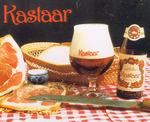
The case of 'Restaurant DEN KASTAAR'
October 2005, severe RFI on my west beverage antenna on the 80m band.
This called for action. By now my bicycle had turned into a real RFI-hunting
unit. A Sony ICF-PRO80 receiver, the Yaesu FT-817ND, a telescopic multi-band
antenna attached to the bike, 80m ARDF equipment, in short, the lot.
My search brought me to a cosy little restaurant Den Kastaar, at a distance
of 1.5 km as the crow flies. Waw, this interference was loud at my place,
what could this be? I picked a quiet moment to talk to the chef. Tried
to explain this technical matter to him, hmm, not so easy. Where did I
live? Could he see my ID-card? Sure, I showed him and then he loosened
up a bit.
The interference was not active when I talked to him, so we agreed I would
call by phone when it was on. Long story short. It appeared to be their
son's switching power supply to his computer screen. I talked to the son
by phone, he told me he had noticed the power supply got really, really
hot lately. Well, something was cooking inside, that was obvious. The
son went for another power supply, case closed (and no fire!). I took
the XYL for dinner to Den Kastaar one evening, we had a lovely meal and
the sympathy of the owners.
So, what has the picture to the left to do with this story? Nothing really,
except that I couldn't find a picture of the restaurant on the internet,
and found this one of a Belgian beer I didn't know yet. Santé!
(oh yes, when I first found this RFI-source, I continued my homebound
bike ride via another road, still listening to my ICF-PRO80. Lo and behold,
I found another interference source, the WNW heading faulty ceiling lamp
of the Ceiling Lamp cases!)
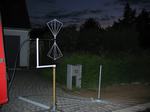
The 'AL BUNDY' case
Shoestores. No more, please. It took me two years to solve this one. The
RFI was caused by a defective high voltage part of neon lighting at a
shoestore. This company was not very cooperative in trying to solve this
particular case of RFI, carrying a potential risk of a fire hazard.
I had to call upon the services of our national Telecom services, their
antennas are visible on the picture to the left, while taking measurements
at my QTH. Here
and here
are some more pictures of their antennas, situated at the shoestore's
side.
The shoestore in the end had to rectify the dangerous situation, it took
way too long for them to do so (end of 2005 to end of 2007!). It appeared
to be a fault in the high voltage part of their neon lighting sign.
This is how the RFI sounded like. It took out the whole 80m band.
A second and longer
soundclip is available, on which the RFI is much less distinct
in strength than the interference on the first clip. That is because when
the lighting was switched on, it took a while for the 'sparks' to get
completely active (and become more dangerous in regard to fire hazard).
With special thanks to our Telecom services for a job well done to bring
this case to a good end.
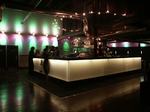
The LATOYA NIGHTCLUB incident
February 2007. A terrible interference on the west beverage, low bands.
I asked Karel ON5TN (he's currently - December 2010 - active from Antarctica
as OR4TN) if he was in for some RFI-hunting. Nothing to do on a Friday
evening, so there we went.
After some walking around with our ARDF fox-hunting equipment, we stopped
at the Latoya nightclub (distance: 1.5 km). This club is situated at a
national route, famous for its brothels. My local ham friends following
my RFI-hunting adventures, were waiting for this day to happen...all these
green and red flickering neon lights, surely on4ww one day would have
the luck of catching a faulty neon sign at a brothel, right?
Anyhow, they can keep grinning until that day happens, the Latoya nightclub
is still one category away...
'Karel, you will stand guard here at the street side. If I don't return
in 10 minutes, call 911'. 'Ok, but hurry up, will you, this place gives
me the creeps!'. Well, this is a place you do not enter by merely opening
the door. I rang the bell, and smiled in the camera. The door unlocked
automatically. I entered a dark and small hallway. A few meters further,
there was a heavy curtain. I pushed it aside and entered a sparsely lit
bar, lounge/disco type. Few men, the older type, and even fewer girls,
the younger type. And a bartender. That was my man! In the noise (music)
I tried to explain what I came for. Not quite what he expected, I imagine.
We went outside, much to the relief of Karel...
When we first arrived at the club, Karel had spotted sparks flying around
at a broken section of the green neon lighting on the roof. We showed
it to the bartender, a smart looking young man. He told us the neon lighting
got dammaged in a storm some weeks before. He already had called for the
neon-company to come over and repair the dammaged section, but they were
not responding. I gave him the address of an alternate company (which
I looked up during the 'Al Bundy' case - it was the same neon-company
that did the installation, and they were also not responding to Al Bundy's
call for a repair!). He then asked us if this interference he could hear
on our radio, could be at the base of the interference he got on the sound/music
installation of the nightclub. Told you, he was a smart looking young
man, and he made a correct assumption-deduction!
This anomaly occured during the cold wet winter months, with sparks clearly
visible on the roof. Had this happened during the previous hot summer,
who knows what could have happened. Another fire prevented? Here
is how it sounded like at a distance of 1.5 km.
Tnx Karel for your brave assistance! Can I call upon your services again
'when the national route real deal happens? Ye know, the red and green
lights'?
The faulty FREQUENCY CONTROLLED DEVICE at a big sportscomplex
Half December 2009, a terrible interference popped up on my southwest
beverage on the 160m band. It was snowing, freezing, no contests, so
I decided to sweat it out a bit. On January 5th 2010 the interference
was still around, and so was the frost. I took out my bike and RFI-hunting
equipment, tucked myself in almost like an eskimo, and off I went. The
interference was repeating every 15 kHz. I carefully tuned my analog
fox hunting device to a frequency on which the RFI was noticeable. I
took the small roads and zigzagged on the icy roads, one hand on the
handlebar, one hand holding the ARDF-equipment, interesting exercise.
Finally, half frozen, at a distance of 2 km I found the interference
source to be in a big sportscomplex. I first talked to the housekeeper,
who got me in touch with the maintenance person. No need to say I made
a perfect entrance and quite an impression - half frozen, tucked in
like an eskimo, with all kind of strange equipment attached to my body
and bike ;-)
At first, not knowing who I was, understandably they told me to get
in touch with the city council's responsible for technical matters.
I contacted one of our club members, Bert ON4DMD who knows quite some
people in that city's community, and then things started rolling and
doors got opened. I spent a lot of time with the technicians, their
manager. Also John ON4UN got along one evening, and we finally detected
the culprit, a faulty frequency controlled device, steering a large
heating system. It was not an easy exercise, the whole complex seemed
to radiate RFI. The outer roof and walls are covered with large metal
protection sheets. Talking about a big antenna, this building was one
hell of an antenna re-radiating the unwanted signals of the RFI-source.
Next follow the technical details.
Click here
to view the video. First you will see and hear (AM mode) the
Yaesu FT-817ND radio picking up the intermittent interference sound,
while a relay clicks away in the background. After the camera zooms
in on a relay; you can see the I/O switch rocking sideways (sorry for
the blurred quality, the macro function was not enabled).
This interference sound was 2 kilometer away from my Beverage antenna,
and loud! It was audible on 1816-1832-1845 kHz-etc. On this
soundclip you can hear how it sounded at my station, at 2 km
distance!
It took 3 evenings and a complete shutdown of the sports and cultural
complex to locate this electrical malfunction. At first we thaught the
industrial relay, labelled C5 on the picture to the left (click to enlarge)
was at the origin of the RFI. However, once this relay was disabled,
the RFI continued. It seemed the frequency controlled device that steers
the large heating system of the sports hall, was at the basis of this
anomaly, and this assumption was proven correct later on.
Notice the blue wire (relay point nr. 4) shows a shade of black, which
may indicate this wire has heated in the past. Due to the malfunction
of the frequency controlled device?
This
picture, shows the 4 red leds (yellow circle nr. 1) and the
green led (yellow circle nr. 2) that were all blinking on the rhythm
of the faulty relay. Here is a video
on which you can just see the green LED go off as the RFI stops.
Thanks to the very helpful crew at this facility for their friendly
and professional conduct in order to help us locate this anomaly! Last
week at a quizz in the sportscomplex (we did not do very well,
tnx for asking) I met again with the friendly technician who was involved
from the beginning of this case. He told me the company responsible
for the heating system, replaced the faulty frequency controlled device.
Case closed. Well, almost. The UBA, our national IARU organisation,
will hold its annual congress in this sportscomplex, May 2010. The people
of the complex already know who those ham radio operators are ;-)
Faulty STREET LAMP at ON4UN
February 2010. John ON4UN calls me for an inteference source hampering
his reception on the 160m band. It turned out to be a faulty street
lamp. During the ignition startup sequence, RFI is strong. Once the
lamp gets activated, the RFI disappears. There is an irregular pattern
of this occurence, coming and going every few minutes. Ray, NR1R, gave
me the following technical explanation on what is happening: the noise
occurs when the sodium vapor start mecanism in the bulb starts arcing;
when the sodium vapor electrode gets hot enough, the bulb lights and
the noise goes away till the bulb goes dead again and the process begins
again. It is called a cycling bulb. The bulb needs replacement when
this occurs. Tnx Ray!
Here is a video
on this type of interference. You will see the blue backlight of a Yaesu
FT-817ND radio, the dimmed street light during interference sequence
(ignition), and the disappearing of the interference once the lamp gets
activated. Here is another video,
taken inside John's shack. You can hear the interference on the K3 radio,
and at the end it drops off (when the lamp gets activated). The radio
is in AM mode.
The photo on the left shows the street lamp, with some of John's towers
visible in the background. This photo
shows the line of sight between towers and lamp (300m).
Remedy to this anomaly? Request the power utility to put in a new lamp.
John has a red telephone line to that company. Over the years, we tracked
down way too many of these faulty streetlight problems. And noisy high
voltage agricultural electric fences... guess that comes with the luxury
of living on the country side.
The TUNNEL case
Truly, this was a difficult one. Late 2004, my reception towards JA
on 160m was hampered by a barely noticeable raised noise level. Just
enough noise, when intermixing with the ever so weak JA-signals, as
to make it impossible to make out callsigns. Out came the bike (it seems
I do more bike trips in winter than in summer) and with a 160m ARDF
fox-hunting unit, I finally made it to 'the tunnel'. This is a rather
big tunnel going under several railway tracks, at a distance of 1.8
km of our house. By sheer coincidence, at that moment I picked up the
RFI caused by trains on my ARDF equipment at that location (going for
one interference, pickin up another one) - more on trains later (the
TRAIN case).
This RFI seemed to be coming from one side of the street, then from
the other side. Strange. Well, it's much more fun doing this stuff in
good company, so I called for John ON4UN and Marc ON4MA. Marc has a
marine radio direction finding unit, it was time to put it to the test.
At first, we thought the RFI came from a light pole. We waited for darkness
to arrive, put on our night camouflage colors, and opened up the small
door at the bottom of the pole in order to get to the breaker switch
(ye know, we're the 'don't do this at home' types). Ho ho, we noticed
some nice sparking inside the pole near the breaker switch. Closed the
door (yeah, well, we're not that daft), and called for the light
pole maintenance crew. Case closed?
Not quite as yet. After the maintenance crew cleaned up the inside mess,
the interference was still around. We got it wrong. Back with all the
equipment, I started to suspect a certain house along the road (see
picture to the left). I could not circumcircle the house, so I wasn't
100% sure and hesitant to knock at the door. Desperate, in the end I
decided to give it a try. A young mother (with baby crying in background)
opened the door. I briefly explained what I came for, if I could contact
her husband? During a phonecall I explained to him what was going on.
If we could meet? During my subsequent visit, it became apparent I picked
out the right house. The good man was plumber by profession, and had
homebrewed a frequency controlled central heating system. Obviously
not according to standard. During another visit, John ON4UN brought
along a filtering unit and grounding equipment. The good man promissed
to install it, off we went and a while later the RFI was gone.
On this soundclip
you hear me talking in Dutch, announcing the monitored frequencies on
an AM receiver. In this order, you can hear the RFI on the following
frequencies: 3.5 MHz, 1.8 MHz, 168 kHz and 7 MHz. In between 168kHz
and 7MHz you can hear me cleaning my boots before re-entering the house.
Tnx John and Marc for your help!
Working on topband means working night shifts. And early morning shifts, just before the sun gets up. My first years with beverage antennas, opened up a whole new world. Not only in being able to work new ones, but in being able to detect all kind of man/machine made noises. The first beverage-years, I often noticed this annoying noise early in the morning. I couldn't pinpoint it, it came and went, on different headings. I listened often to this sound (in AM mode), and because of that, I immediately recognized the same sound while watching a train go by in 'The TUNNEL case'... mystery solved!
Here is a soundclip of a train passing by... at 1 km distance! Think I made this recording in AM mode, on CW it sounds not as distinct but is still pretty annoying. I can more or less follow the train on my beverages... usually starting on south heading, going over southeast and east, and finally disappearing on northeast.
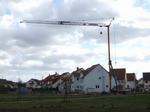
The CONSTRUCTION CRANE case
January 2004. Now, this was a nasty one. In those days I was still chasing
Worked All States on topband, and I got up almost every morning during
the lowband seasons, October through March. And this for many years, before
it finally happened tnx to KL7HBK on 17 October 2005. John was my last
state, my last zone and a new entity, all at once, tnx John! Finally some
more sleep during the winter seasons ;-)
And to say that ON4AOI worked his WAS in two weeks, early 2010! Now that
is not fair...
What happened? I got up early in the morning(s), started calling CQ NA
in the hope for a new one. All of a sudden a terrible noise comes on,
for 10, 15, sometimes 30 seconds. What the heck is this now?
On February 20th I got so fed up with it, I took my bike and started a
two person posse to try and find this little bastard. I positioned myself
at 800m from our house, in the heading of where the noise was coming from.
In my shack, Karel ON5TN came to rescue and informed me on 2m band when
the noise was on (because of the very short time frames, it was very handy
when Karel alerted me when the RFI started - I could stop the bike and
start direction finding). After a while of trial and error, I arrived
at a construction site, 1.6 km distance from our home. A big and deep
pit, concrete pouring, construction workers running around. I rode back
and forth, always getting back to this site, but not able to pinpoint
the source.
I was standing across the street, when all of a sudden the noise came
back. I took out my earphones, and could actually hear the same noise
coming from across the street! And noticed it stopped when the construction
crane stopped operating. Eureka!
I talked to the construction workers, later got in contact with the company
selling these cranes. Two of its technicians came to the contruction site,
where we had a meeting and did some tests with shielded cables and proper
grounding, to no avail. John ON4UN then brought the company in contact
with a professor at the University of Ghent, specialized in this matter
(frequency controlled devices and RFI). He recommended acquiring specific
filtering materials. Fast forward, June 2004. The company had not received
the filtering materials yet, and priorities started shifting. October
and December 2004, e-mails stay unanswered. End of December I make a phonecall
to the contact person. He tells me he has been taken off the case and
gives me the name of his successor. He also tells me he thinks no filters
have been tested and no progress has been made. Restructuring in the company
makes for different priorities. In March 2005 I detect RFI from a construction
crane, from another manufacturer, at 2 km distance ('Construction Crane
2' on the Overview
picture). October 2005, another crane from the first company gives
me trouble.
John suggests I contact our national Telecom service for assistance in
this particular case. By then, his radio reception also got hampered by
a construction crane in his neighborhood. On 25 October 2005 we sent a
detailed account of all facts to our national Telecom service. By the
time their investigation got underway, unfortunately the involved construction
cranes were dismantled. Case not really closed, as these types of cranes
pop up on new construction sites ever so often.
Here is a soundclip
of the first ever RFI-construction crane I encountered. You will understand
that it is impossible to copy any weak signal on topband with this type
of heavy interference. Distance from antenna to crane is 1.6 km.
Can it get worse? Here is a soundclip
of two construction cranes hampering my reception on topband simultaneously!
The icing on the cake comes in this soundclip:
a construction crane operational at 2 km distance and a train passing
by at 1 km distance...all at once...wonderful!
Well, we can debate if this is RFI/EMI or not, but it sure makes a lot of noise. You can often hear this on yagi antennas, but also beverages are prone to it. Can be induced by snow, hail, even dry cold air. This kind of interference is one of Murphy's favorites during the CQWW contests... here is a soundclip.
The LED LIGHTING case at a Porsche garage
Aaah...the Porsche garage. Friendly and cooperative people. At a distance
of 800m, two instances of RFI hampered my lowband reception. December
2009, I picked up this
rather strong interference. As it was on my north beverage,
it had to be on the (in)famous national route (see 'the Latoya nightclub
incident'). I took the car this time, with all my gear inside. Took
a walk and ended up at the showroom of a Porsche garage. Upon entrance
and explanation to the employees, I was granted permission to walk around.
The RFI was emanating from a circuit that was switched on at opening
time, and switched off at closing time. It was just around closing time,
so I could easily monitor which circuit was being switched off, one
at a time. When finally the LED lighting at the computer desk was switched
off, the RFI disappeared.
One of the employees told me they were not happy with the LED lighting
(not adequately lighting their computer desk), and they already had
called for the lighting company to make some changes in the near future.
I sent this company twice an e-mail (March 2010) with detailed info
on the problem, the e-mails stayed unanswered. I was going to call upon
the services of our national Telecom service again if the problem was
still around the next lowband season.
When I put up the beverages in October 2010, the problem was gone. This
problem was most probably related to a 'dirty' power supply of the LED
lighting. Our son recently installed two different LED lighting circuits
in our living room. Two different power supplies, a good one, and a
'dirty' one giving loud interference on 160m band, but only audible
on the Inverted-L antenna, not on the beverages. The RFI was weak because
the electric cabling from the power supply to the LED lighting was very
short. If the cabling had been longer (such as in the Porsche garage),
the RFI would have been stronger and would be picked up by the beverages
as well.
In 2005 during the CQWW CW contest, Murphy paid me a visit big time.
I wrote a little story
about it, still makes me smile. Just that weekend the Porsche garage
had open door, showing the latest Porsche model. For this they probably
worked together with Dior (customer gifts?) and a Dior neon sign was
put outside, see picture to the left. I didn't record the RFI (if you
read the story, you'll understand why), but it made a hell of a noise...what
a weekend!
To top it off, in my search for the RFI caused by this neon sign I first
knocked at the door of the company next door to the Porsche garage,
MacNight, a bedding shop ('Airconditioner' on the Overview
picture). Some terrible interference was picked up, it appeared
to be a faulty airconditioning. The shop employee admitted the electrical
household in the shop was a disaster. He disabled the breaker switch
of that particular unit and would call for an electrician to have a
look at it.
After reading Murphy's story again, I think I had better reserved a weekend at MacNight, sleeping all weekend long instead of playing the CQWW ;-)
This was an easy one. In 2003 I bought a couple of fluorescent tube lamps to be installed in my new shack. They are ignited with an electronic starter. On this video you can witness the result of a badly engineered fluorescent tube with electronic starter, causing heavy RFI on 28 MHz. Distance from the 28 MHz antenna to the lamp is 25 meter. If anyone has an easy solution for this one, let me know pse (yes, I know I should get a conventional starter).
The Samsung PLASMA TV case
For some years I had an annoying interference that was centered smack
in the middle of the 80m (75m) SSB DX window. As I was not very active
on 80m in those days, I didn't immediately tackle the problem. November
2004, it was time to take out the bike. I located the RFI source in
a used car sales shop. The RFI was caused by a Samsung plasma TV, model
P2. It was continuously on during daytime and late in the evenings.
The RFI at 800m distance was noticeable at 200 kHz intervals. When close
to the TV with a portable receiver, it was noticed that the TV radiated
non-wanted signals from LF into VHF spectrum. Waw. The RFI on the soundclip,
is recorded first on LSB, then AM mode, and back on LSB at a distance
of 800m.
I first contacted Johan ON4IQ who was responsible for technical service
at the TV cable company. At first I thought the RFI was originating
from the cable company's outside distribution box near the street side.
That box radiated terribly! Johan sent a technician, who changed an
outside connector and inside the house another connector (there was
no grounding at the TV side). This did not solve the problem. I then
got in touch with Samsung, and after a lengthy process they replaced
the P2 with a P3 model. They first sent a technician with another P2
model to our house, we installed it for a test setup, same problem.
I then went to visit Samsung's technical facilities near Antwerp, where
I 'sniffed' a P3 model with my Yaesy FT-817ND. The P3 model was clean!
Bad engineering on the P2 model, but good and helpful response from
Samsung!
In 2010 I got a Samsung LED TV myself, that one is clean. If it is good,
we show it too...here is a videoclip
of my clean Samsung. See the text on Youtube for more details on this
test.
Update January 2013 on my Samsung LED tv. This year-2010-unit is clean in that it does not generate RFI to my radio. However, I found out (tnx to my xyl) that my radio was interfering with the Samsung! On several bands (80-40-10m and probably other bands as well, not checked), the tv would switch on and off when transmitting. Also, the tv would every time go into DEMO (shop) MODE, and settings for the sound (Samsung sound when switching on/off) would be altered. Very annoying. I tried everything from putting ferrite onto the coax, power cord - disconnect peripheral cables (hdmi, etc.) - Corcom EMI filter. Nothing helped. Google came to rescue and I found a Dutch ham forum which described this exact problem (you can put it through a translate machine). It appears the touch switch panel at the front of the tv, is picking up RF and causing the mayhem. On this forum is described how to disconnect the touch switch panel circuitry by pulling out a connector. Problem fixed. As a result you can only 'talk to the tv' with your remote control. I am sure Samsung by now is aware of this problem. Another hiccup from the engineering department, which hopefully will be rectified in future models. Here is a photo page showing how I tackled this problem.
The Panasonic VIERA PLASMA TV case
Both my son (still living at home) and my closest neighbors have a Panasonic
Viera plasma TV. This thing breathes RFI. In this video
I use a Yaesu FT-817ND as receiver in AM mode, with a very insensitive
telescopic antenna. The video starts with the tv switched off, and the
receiver on 50 MHz. When the tv is switched on, you can clearly hear the
interference come up. I then switch down in frequency: 28-24-21-18-14-10-7-3.5
and 1.8 MHz. Waw, this tv really radiates unwanted signals! When I switch
channels on the tv, you can hear the RFI disappear in between channels,
to come up again when the next channel pops up. At the lower frequencies
of 3.5-1.8 MHz, I change the frequency a bit on the receiver to find the
RFI. Apparently with the very insensitive antenna, only the stongest RFI
signals are picked up. But mind you, with resonant outdoor antennas, you
can hear the interference all over the radio spectrum. Bad engineering,
Panasonic!
I know of other Belgian hams who have similar problems with this Panasonic
Viera. In Germany, a court order forbid a neighbor of a ham to watch his
Panasonic until the RFI has been cured. Way to go! Also in The Netherlands
things are moving, and the national Dutch PTT has in cooperation with
Panasonic replaced 'dirty' models by clean ones. Our national Telecom
service has been asked to do the same, and I am confident they will.
In this video
you can witness how the Panasonic sounds on 28 MHz. Receiver used is a
Yaesu FT-1000mp in AM mode (preamp off).
The yagi antenna at first points in a direction where no RFI is picked
up. While the yagi turns, you can hear the interference come up. I then
sweep a bit over the 28 MHz spectrum, nice eh? At the end the antenna
is turned away from the Panasonic (at 35 meter distance) and the RFI disappears.
Come on plasma TV engineers, you can do better!
The E-MAIL case
This is a truly intriguing and fascinating story.
On November 2, 2008, John G3PQA sent an e-mail to topband reflector about
a new interference he experienced during the last month. His e-mail rang
a bell with me. Together with Hugo ON7GB I had just started to investigate
a very strong and annoying interference that blocked the 160m band. Could
this be the same interference?
I got in contact with John, and we immediately started the posse. John
brought along Paul G4PWA, Keith G3RPB and Ian G3NRW. On the Belgian side
Marc ON4MA and John ON4UN completed the team.
It has to be said, the team went full speed and full force ahead to try
and nail this border crossing interference. The CQWW contest was nearing,
without a solution topband would be useless during the contest.
To show what is possible if a couple of like-minded hams get together,
I put all e-mails chronologically in this .pdf
file. In this 20 page document (yes, quite some e-mails went back and
forth!), some hyperlinks to pictures, websites and soundfiles are included.
Together with the e-mail content you'll get a good understanding of what
was going on.
I was VERY eager to hit the road and do some direction finding on this
RFI source. I had already driven 5 km in the neighborhood with my fox-hunting
ARDF equipment prior to receiving John's e-mail of November 2, and it
became obvious that it was not a local, but long distance RFI source.
I was nearly on my way to Berlin, at one stage during the investigation!
Unfortunately I was plagued by a hernia at the time I wanted to go for
'the long distance hunt', and that may well be the reason we did not find
the source. The RFI simply died between November 13 to 15. When I was
finally able to go on a hunt on November 11, John ON4UN and myself went
out with all sort of direction finding equipment. First stop was to be
at ON7GB, who had the interference very strong on his TX-antennas. On
the way to Hugo, we stopped at a McDonald's, took a bite, and to our surprise
we kinda heard the RFI 'die'. It came back the following days, but more
intermittently, to finally never come back. We had a nice visit at Hugo's
place though, and that same day found an 80m RFI source near ON4UN's place!
What was it? We'll never know. Reviewing all the e-mails, I am convinced
it originated in the vicinity of Antwerp. Too bad we didn't find it, would
have been a great case to solve.
But it was a very gratifying experience to get an international group
of hams working together in such a dedicated way. Ham Radio at its best?
You bet!
Although this is not a typical RFI source, it can be very annoying and is indeed interfering when listening to weak signals on the 80m and 160m bands. A 10 second tone is followed by 7 seconds of two different alternating tones. These signals were first heard in 2009. ON4UN, ON4MA and myself can hear many of them in our neighborhoods. Over a period of 1 year, many more popped up. At one stage we believed it might be connected to more and more people watching digital TV. A settopbox? I had pinpointed one source already end of 2009, but didn't ring at the doorbell until 14 October 2011. Thanks to a very gentle and helpful houseowner, the real culprit has finally been determined. It has nothing to do with digital TV, it is all about solar panels. This signal is generated by an inverter manufactured by SMA Solar Technology (Germany) and distributed by Schüco Germany (model SB3000). The leads going up to the solar panels act as antenna and radiate the two-tone signal. I was planning to contact Schüco/SMA to see what possibly can be done about this, but don't have the time to invest in what possibly could be a lengthy correspondence process. Perhaps someone in Germany could approach them? It is clear that these devices are radiating signals that are not supposed to be radiated. Another possibility is that the signals are generated by another device in the electrical cabinet, and passed through the inverter, but this seems rather unlikely to me. This recording was made at a distance of 1 km. Some people may think it is the Hyperfix signal (heard in western Europe below 1825 kHz), it is not.
The automatic CLOTHES-MACHINE case (by Chuck W1HIS)
My automatic clothes-machine has a variable-speed motor drive that uses
high-power solid-state electronic switching. L-C filtering of its 240-VAC,
60-Hz, power-line connection, and extensive ferrite-choking of cables
inside and outside the machine, failed to reduce the RF noise level
on the power wiring of my house. Of course the power wiring radiated....
By sniffing, I found a very high level of RF noise current on hot and
cold water pipes throughout my house. These pipes radiated, too.
Inside the washing machine was an electric immersion heater, intended
to increase the wash-water temperature if/when necessary. This heater
was coupling RF noise from the electric wiring inside the machine to
the water. Aggressive choking of the electric power wiring to this heater
did not sufficiently reduce the noise current on my water pipes.
What did solve the problem was installing snap-on, split beads, of
ferrite on the hoses that delivered hot and cold water to the machine.
The outsides of these hoses were covered by stainless-steel wire braid,
for mechanical reinforcement. However, this wire braid was insulated
at the washing-machine end of each hoses. It was water that carried
RF noise current from inside the washing machine to each hose.
The braid aggravated my RFI problem by reducing the distance that noise
current had to travel through water. After the noise current had emerged
from the washing machine by conduction and displacement current through
the water, it could continue essentially without loss as conduction
current on the braid.
However, the wire braid exacerbated my RF noise problem more strongly by another, more subtle mechanism. The braid on the hot-water hose lightly touched the braid on the cold-water hose. This contact was a non-ohmic (nonlinear) conductor. The combination of (1) electronic-switching noise current from the washing machine and (2) current induced in my water pipes by powerful, MF and HF, AM broadcasting stations flowing through this nonlinear contact yielded intermodulation products that blanketed the MF and HF ham bands.
I eliminated this intermodulation by wrapping the cold-water hose with dielectric tape. I attenuated the electronic-switching noise current on the hoses further by connecting each of the wire braids to the metal body of the washing machine. One might might expect these connections to increase the RF noise current reaching my pipes; but they did the opposite. Via these connections the braid returned, to the washing machine, the displacement current due to capacitance between the water inside each hose and the braid on the outside. This solution addressed the essential problem, which had been that noise got out of the washing machine via the water.
The following photo shows how I connected the hose braids to the body of the washing machine.
The next photo shows how I sensed ("sniffed") the RF current in a hose. Noise current sensing is extremely important for understanding how noise power gets from a source to a conductor that's long enough to radiate it efficiently. Without such sensing, it's difficult to know how to solve a noise problem, and how effective a particular remedy is.
In the photo I am holding one side of a rectangular loop of insulated wire against the hot-water hose, near the end of the hose that connects to the hot-water supply pipe (where a shutoff valve has a red handle). The rectangular form is maintained by a sheet of cardboard, to whose perimeter the wire is fastened. Current flowing along the hose generates a B-field that encircles the hose and passes perpendicularly through the rectangular aperture of the loop. The flux of B through the loop generates an e.m.f., or "voltage," in the loop. At the lower right corner of the loop is a tiny gap, or "feedpoint," across which a coaxial cable is connected. This coaxial transmission-line carries the noise voltage to an HF receiver. The shield of this coax continues around the loop but does not bridge the tiny gap. Therefore, only the magnetic flux through the loop, and NOT stray electric fields (due, for example, to electric charges on my hand and the hose, contributes to the signal/noise seen by the receiver.
This rectangular, electrically shielded, B-field-sensing loop is highly specific. In the present case it is enabling me to distinguish between current in the hot-water hose, and current in the cold-water hose. In other situations, e.g., inside a washing machine or an electric power-distribution "load center" or "circuit-breaker panel," it enables me to see which of many wires/cables is carrying noise current. A whip antenna on a portable receiver, which responds to electric field, is MUCH less specific and much less useful. Its sensitivity pattern is not nearly so well defined, as one can deduce theoretically as well as empirically.
This loop is also useful for direction-finding in the far field (the radiation field, as opposed to the induction field) of a noise source. However, its sensitivity is relatively poor because it is not tuned, i.e., impedance-matched to the receiver. A tuned loop is better for DF'ing, unless the noise is very strong.
73 de Chuck W1HIS
